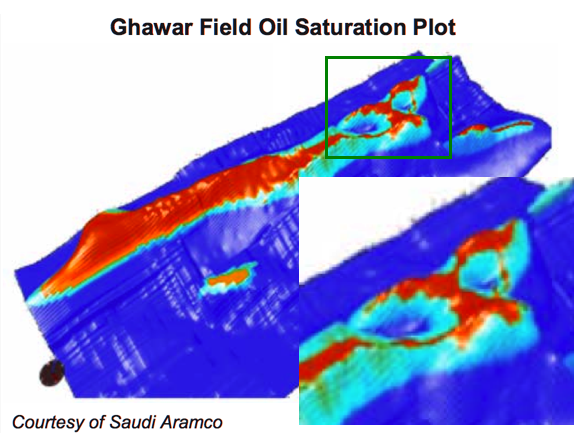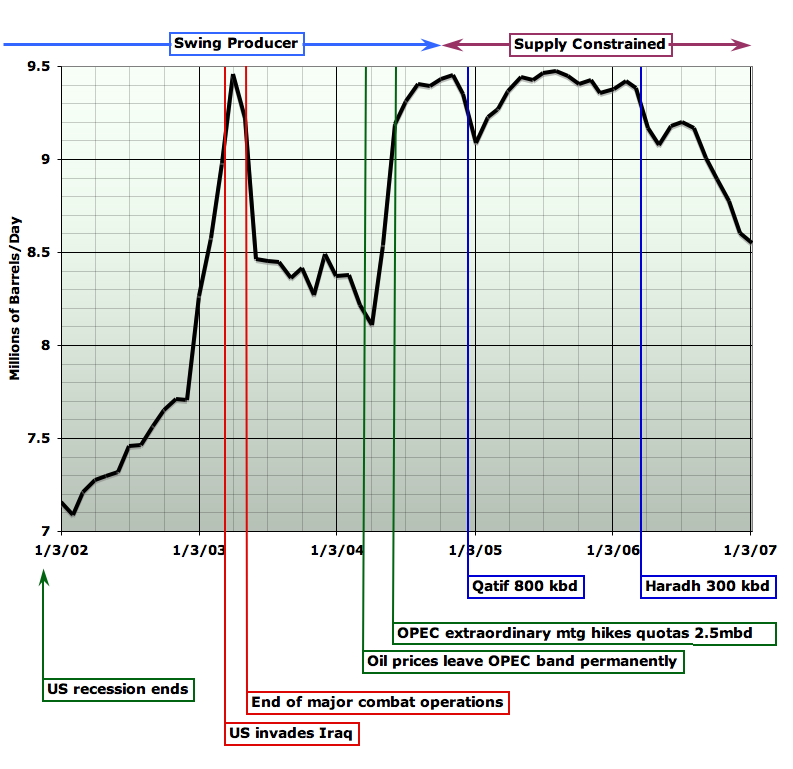
Visualization of oil saturation in Ghawar, with focus region on 'Ain Dar and Shedgum regions at northern end. This is the "Linux Supercluster" picture (finder's credit Bob Shaw), showing a simulation visualization of the state of Ghawar at some year, probably but not certainly 2004. I have color reversed the original picture so that in this version, the red areas are interpreted to represent dry oil in the reservoir. The dark blue areas are water below the oil. The pale blue areas are interpreted to be swept, with most oil that can be removed already gone. Source: Figure 3 of Linux Clusters Driving Step Changes in Interpretation Simulation (pdf).
Mr. Staniford then asks:
Here the question is: is this an accurate picture of the state of recent depletion of Ghawar? (Ghawar is the world's largest oil field, and source of over half of the oil produced by Saudi Arabia).
And if so, then the second question arises: does that depletion have anything to do with this picture?

Saudi Arabian oil production, Jan 2002-Jan 2007, average of four different sources. Annotations show important events causally influencing production, including all documented megaprojects for new supply in the the time period. Graph is not zero-scaled to better show changes. Click to enlarge. Source: US EIA International Petroleum Monthly Table 1.1, IEA Oil Market Report Table 3, Joint Oil Data Initiative, OPEC Monthly Oil Market Report, Table 17 (or similar) on OPEC Supply.
In particular, Saudi oil production has been falling with increasing speeed since summer 2005, and overall, since mid 2004, about 2 million barrels of oil per day in production has gone missing (about 1mbpd in reduction in total production, and about another 1mbpd in that two major new projects, Qatif and Haradh III, failed to increase overall production). That's 2.5% of world production and, if that production hadn't gone missing, gasoline in the US likely would still be somewhere in the vicinity of $2/gallon instead of well over $3.
I will analyze six or seven separate lines of technical evidence, and argue they all point to a consistent picture, which says that the answer to both questions is "Yes". Yes, the northern half of Ghawar is quite depleted. And yes, this probably explains at least part of recent production declines. Furthermore, it is likely that more declines in Saudi production are on the way.
I don't know if this is disinformation just meant to create panic (and therefore drive up the price of oil), or if the shortage due to this one region is just temporary. I can just tell you that the general feeling is that cheap oil is starting to run out. In any case, I think that the link at the top is worth a look.
Before I go on, I think I should give a disclaimer (which I am borrowing, for the most part, from Mike Shedlock's site):
The content on this site is provided as general information only and should not be taken as investment advice. All site content, including advertisements, shall not be construed as a recommendation to buy or sell any security or financial instrument, or to participate in any particular trading or investment strategy (or an endorsement or recommendation of any product on any ad). The ideas expressed on this site are solely the opinions of the author(s) who may or may not have a position in any company or advertiser referenced above. Any action that you take as a result of information, analysis, or advertisement on this site is ultimately your responsibility. Consult your investment adviser before making any investment decisions.
If Saudi Arabia is truly starting to run out of oil, then we here in America need to get cracking developing technology to make our use of oil more efficient and develop alternative forms of energy. Most of our electricity comes from burning coal; and while we have a 250-year supply of it, it burns very dirty. Different areas of the country are more suitable to other, cleaner, forms of energy production: solar, wind and hydro power. Each of these are renewable and relatively clean forms of energy production. While current technology does not allow for these forms of energy production to be used widely, it would be wise for Americans to put our smartest minds to work creating more energy-efficient automobiles and buildings. Rather than looking toward converting food crops into more oil for our cars, we need to focus on making our cities more fuel efficient and develop more mass transit lines so that we can cut unnecessary oil usage.
It is my feeling that we, here in America, need to use our strength of innovation to solve our energy problems rather than looking for ways to produce more energy. Our real problem is that we are wasting too much energy that we have access to now. Reducing the demand on oil by conserving and increasing energy efficiency would be the smartest and most effective method of driving down our energy costs.
No comments:
Post a Comment